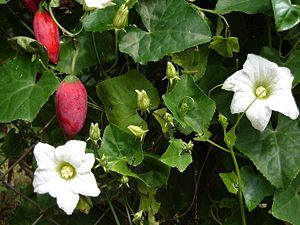Tindola
| Tindola | ||||||||||||
|---|---|---|---|---|---|---|---|---|---|---|---|---|

Tindola ( Coccinia grandis ) |
||||||||||||
| Systematics | ||||||||||||
|
||||||||||||
| Scientific name | ||||||||||||
| Coccinia grandis | ||||||||||||
| ( L. ) Voigt |
Tindola or scarlet tendril ( Coccinia grandis ) is a crop from the cucurbit family (Cucurbitaceae).
features
The tindola is a perennial herbaceous climber with tubers that forms smooth stem axes up to 5 meters in length. The leaves are alternate, have a 5 to 55 millimeter long stem and are simple. The leaf blade is 3 to 11 inches long and 3 to 13 inches wide, pentagonal to palmate lobes, with a heart-shaped to arrow-shaped leaf base. The leaf shape is decisive for the English common name Ivy Gourd ("ivy pumpkin"). The leaf margin is serrated. The blade is bare.
The species is dioecious separately sexed ( diocesan ). Sex is determined using sex chromosomes . Similar to humans, female plants have two X chromosomes and male plants one X and one Y chromosome, the Y chromosome in C. grandis being more than 2.5 times larger than the other chromosomes. The flowers are usually solitary in leaf axils, very rarely in clusters with few flowers . They are snow-white in Asia and cream-white in Africa. The flower stalk is up to 32 millimeters long. The calyx lobes are 1.2 to 3.5 millimeters long and five-fold. The crown is 1.7 to 4 centimeters long and also five-fold. The anthers of the three stamens have grown together to form a column.
The ovary has three parts, inferior and carries numerous ovules. There is a stylus with three bilobed stigmas . In female flowers there are three small sterile stamens (staminodes).
The fruit is a fleshy, (scarlet) red armored berry 60 millimeters long and spherical to ellipsoidal in shape. It is around 35 millimeters wide.
The number of chromosomes is 2n = 24.
distribution
The species is native from Africa to Southeast Asia and Malesia and is also grown here. It has also been introduced to Latin America, Australia and other tropical areas.
use
The ripe fruits are eaten raw, boiled or candied. Leaves, young shoots and unripe fruits are eaten cooked as vegetables. Different parts of the plant are used medicinally. Sometimes the species is also planted as an ornamental plant. Leaves and young shoots are relatively rich in potassium, iron, zinc and selenium, and the amino acid composition of the proteins is also beneficial for humans.
The tindola is often propagated using cuttings , with around 10 times as many female as male plants being planted. The cuttings are pulled on trellises at a distance of one to two meters. Irrigation is often necessary. Some land races develop without fertilization ( Parthenocarpic ). A single plant can produce up to 300 fruits per season.
Invasive plant
The species is classified as an invasive species in a number of areas where it has been introduced . Because it forms a thick layer of vegetation, it crushes the vegetation below it. It is considered to be very aggressive on Guam and Saipan . In Hawaii , it is considered a problem in gardens, on roadsides, and in natural vegetation. The control is carried out in part by spreading insects, such as the beetles Acythopeus cocciniae and Acythopeus burkhartorum ( Curculionidae ) and the butterfly Melittia oedipus ( Sessidae ). Further types of control are the application of 2,4-D or triclopyr to the basal parts of the trunk or of triclopyr and dicamba to the leaves; mechanical control is ineffective.
literature
- Norbert Holstein: Monograph of Coccinia (Cucurbitaceae). In: PhytoKeys , Volume 54, August 2015, pp. 1–166, doi: 10.3897 / phytokeys.54.3285 .
- Amanda Spooner, James Carpenter, Gillian Smith, Kim Spence: Coccinia grandis . In: Florabase, the Western Australian Flora , accessed April 13, 2008. (Features)
- RW Robinson, DS Decker-Walters: Cucurbits . CAB International, Wallingford 1997, p. 111. ISBN 0-85199-133-5 (usage)
Individual evidence
- ↑ Coccinia grandis at Tropicos.org. In: IPCN Chromosome Reports . Missouri Botanical Garden, St. Louis
- ↑ Xu YouKai, Liu HongMao, Dao XiangSheng: The nutritional contents of Coccinia grandis and its evaluation as a wild vegetable. Acta Botanica Yunnanica, Volume 25, 2003, pp. 680–686 (abstract) ( page no longer available , search in web archives ) Info: The link was automatically marked as defective. Please check the link according to the instructions and then remove this notice.
- ↑ Coccinia grandis on the Global Invasive Species Database , accessed April 13, 2008.
- ↑ R. Muniappan: Biological Control of Ivy Gourd, Coccinia grandis on Guam . Research project on Guam ( Memento of the original from October 11, 2008 in the Internet Archive ) Info: The archive link was inserted automatically and has not yet been checked. Please check the original and archive link according to the instructions and then remove this notice. , accessed April 13, 2008.

